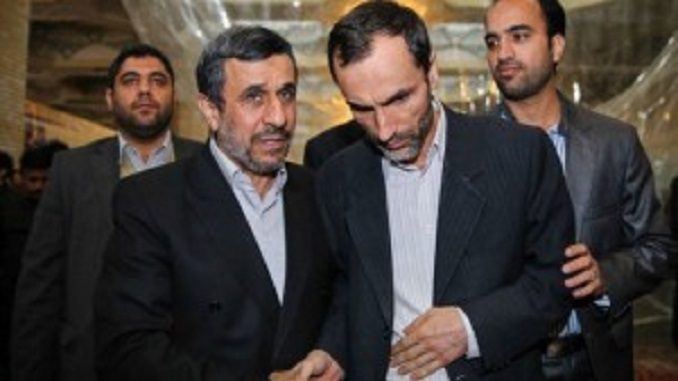
“Revenge for Allah” militias, an extremist hardline group in Iran, attacked officials belonging to the administration of former Iranian President Mahmoud Ahmadinejad, who is currently taking refuge at a religious shrine in Tehran, Track Persia reports.
The group reportedly carried out the attack on Saturday as a way to protest against the charges of corruption against them. Ahmadinejad’s unofficial website, Dolat-e Bahar, published pictures and videos of the attack and reported that members of the extremist groups were loyal to the head of the Iranian judiciary, Sadiq Amouli Larijani. They also beat supporters of Iranian former vice president, Hamid Baghaei, former media adviser Ali Junafkar, and former senior government official Habibullah Kharasani, all who have been carrying out a religious sit-in since Wednesday at Shah-Abdol-Azim shrine.
Ahmadinejad delivered a speech on Wednesday for his supporters who gathered to support the former president’s assistants before the sit-in, during which he attacked the head of the judiciary Ayatollah Sadeghi Amoli Larijani and his brothers, accusing them of “stealing public money and corruption.”
In his speech at the holy shrine, Ahmadinejad declared his opposition to the Larijani family — a third brother, Mohammad-Javad Larijani, heads the judiciary’s human rights council, and there are two other brothers and many family connections with power — and said it was important not to let them take control of the government. Considering that two of the Larijani brothers are already in two of the country’s most powerful positions, Ahmadinejad must have been warning of the brothers’ chances of becoming president of the Islamic Republic and occupying the office of the Supreme Leader.
His recent attacks, and his behavior over the last few years, can best be interpreted as the tactics of a proxy warrior, the moves of a small paramilitary force fighting on behalf of others who want to block the Larijani brothers from gaining political ground. These groups and individuals Ahmadinejad fights for would naturally be delighted if the quarrel continues, and especially if it intensifies.
Holding sit-in protests inside religious shrines dates back to the Qajari era (1779-1925), when critics fleeing from the Qajari government resorted to it as they were afraid of being chased by security. The sit-in of Ahmadinejad’s government officials in this way is the first of its kind and the most severe types of protests that can be carried out by figures that belong to the Jurist ruling regime.
Ahmadinejad had visited his assistants on Saturday, amid cheers from his supporters demanding the Iranian leader to isolate Larijani and his brother from the presidency of the judiciary and parliament.
Conflict increased between Ahmadinejad’s party and Larijani’s two brothers, who dominate the judiciary as well as a broad sector of the economy, since he challenged the supreme leader Ali Khamenei, when he announced his candidacy for the presidential elections in May, after the leader recommended not to run on the pretext of preventing “polarization” state in Iran, which made the Guardian Council under the rule of Khamenei, to reject the nomination of the former president and his VP Baghaei on the pretext of their “incapacity to run in the presidential election.”
Ahmadinejad has launched an attack against Khamenei, accusing him of condoning the people, likening him to the former Shah, who was overthrown by the revolution in 1979. Iran depends on its regional meddling as a show of force, intimidating neighbors and warning global leaders to back off. But events at home tell a very different story.
Growing domestic unrest has plagued the regime and reveals to the international community the biggest chink in Iran’s armor. That chink was on display on October 29, as the regime launched a massive crackdown to prevent a planned gathering marking International Cyrus Day, in memory of the ancient Persian emperor known to be the author of the world’s first human rights charter. His choice by the people was not accidental, and Tehran officials got the message. Reports indicate the government deployed more than 6,000 Revolutionary Guards (IRGC), Basij and Intelligence Ministry agents to prevent the gathering from getting out of control.
Further domestic unrest surfaced in the growing number of protests by ordinary investors who discovered their life savings in state-run institutions had been plundered. The Iranian regime has usurped billions from ordinary people’s investments to fuel its wars across the region. After 38 years, this has left the Iranian people in dire straits. Rampant corruption and pervasive mismanagement add to the problem, leaving little hope for any improvement in economic or social conditions.
